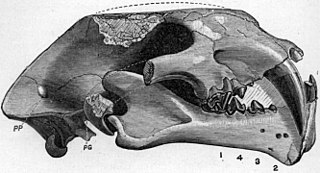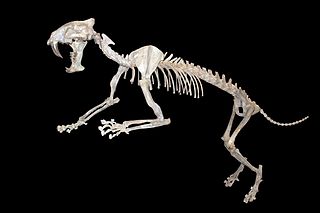
Pseudaelurus is a prehistoric cat that lived in Europe, Asia and North America in the Miocene between approximately twenty and eight million years ago. It is considered to be a paraphyletic grade ancestral to living felines and pantherines as well as the extinct machairodonts (saber-tooths), and is a successor to Proailurus. It originated from Eurasia and was the first cat to reach North America, when it entered the continent at about 18.5 Ma ending a 'cat-gap' of 7 million years. The slender proportions of the animal, together with its short, viverrid-like legs, suggest that it may have been an agile climber of trees.

Nimravidae is an extinct family of carnivorans, sometimes known as false saber-toothed cats, whose fossils are found in North America and Eurasia. Not considered to belong to the true cats, the nimravids are generally considered closely related and classified as a distinct family in the suborder Feliformia. Fossils have been dated from the Middle Eocene through the Late Miocene epochs, spanning about 33.2 million years.

Pogonodon is an extinct genus of cat-like nimravid endemic to North America during the Oligocene.

Eusmilus is a prehistoric genus of nimravid that lived in Europe and North America during the Late Eocene to Early Oligocene epochs.

"Pangur Bán" is an Old Irish poem written in about the 9th century at or near Reichenau Abbey, in what is now Germany, by an Irish monk about his cat. Pangur Bán, 'White Pangur', is the cat's name, Pangur possibly meaning 'a fuller'. Although the poem is anonymous, it bears similarities to the poetry of Sedulius Scottus, prompting speculation that he is the author. In eight verses of four lines each, the author compares the cat's happy hunting with his own scholarly pursuits.

Hoplophoneus is an extinct genus of the family Nimravidae, endemic to North America during the Late Eocene to Early Oligocene epochs, existing for approximately 6 million years.

Barbourofelidae is an extinct family of carnivorans of the suborder Feliformia, sometimes known as false saber-toothed cats, that lived in North America, Eurasia and Africa during the Miocene epoch and existed for about 7.9 million years. Thought to be an independent lineage from the Nimravidae and Machairodontinae, which had all attained elongated canines, recent research argues that it may be a subfamily of the Nimravidae, extending its biochronological range into the Miocene, although this issue is not yet fully resolved.

Feliformia is a suborder within the order Carnivora consisting of "cat-like" carnivorans, including cats, hyenas, mongooses, viverrids, and related taxa. Feliformia stands in contrast to the other suborder of Carnivora, Caniformia.

Simocyon is a genus of extinct carnivoran mammal in the family Ailuridae. Simocyon, which was about the size of a mountain lion, lived in the late Miocene and early Pliocene epochs, and has been found in Europe, Asia, and rarely, North America and Africa.
Dinaelurus is a genus of the Nimravidae, an extinct family of feliform mammalian carnivores, also known as "false saber-toothed cats". Assigned to the subfamily Nimravinae, Dinaelurus was endemic to North America during the Oligocene epoch, existing for approximately 10.2 million years.
Dinailurictis was an extinct nimravid carnivoran belonging to the subfamily Nimravinae. It was named in 1922, with subsequent material being recovered from middle Oligocene deposits across France and Spain.
Quercylurus major is an extinct, cat-like nimravid carnivora from the early Oligocene of France. Its fossils were found in Early Oligocene strata in Quercy. Q. major was possibly the largest nimravid ever known, as its fossils suggest it was similar in size to the modern-day lion.

Sansanosmilus is an extinct genus of carnivorous mammal of the family Barbourofelidae endemic to Europe, which lived during the Miocene, 13.65—9.7 mya, existing for approximately 3.95 million years.
The cat gap is a period in the fossil record of approximately 25 million to 18.5 million years ago in which there are few fossils of cats or cat-like species found in North America. The cause of the "cat gap" is disputed, but it may have been caused by changes in the climate, changes in the habitat and environmental ecosystem, the increasingly hypercarnivorous trend of the cats, volcanic activity, evolutionary changes in dental morphology of the Canidae species present in North America, or a periodicity of extinctions called van der Hammen cycles.

Asiavorator is an extinct genus of civet-like carnivoran belonging in the family Stenoplesictidae. It was endemic to Asia and lived during the Eocene and Oligocene epochs.
Eofelis is an extinct genus of small nimravid. They were catlike creatures that evolved in parallel with true cats but are not a part of the true cat lineage and have left no living descendants. The genus was first described in 1938 by Miklos Kretzoi.

Palaeonictis is an extinct genus of placental mammals from extinct subfamily Palaeonictinae within extinct family Oxyaenidae, that lived in Europe and North America from the late Paleocene to the early Eocene.

The Brule Formation was deposited between 33 and 30 million years ago, roughly the Rupelian age (Oligocene). It occurs as a subunit of the White River Group in South Dakota, Nebraska, Colorado, North Dakota, and Wyoming.
Nanosmilus is a nimravid from the Oligocene of Nebraska. As a member of Feliformia, it is related to the superficially similar-appearing true cats. As such, it and nimravid genera in general are often referred to as false saber-toothed cats. No larger than a small bobcat, it is the smallest known saber-toothed mammal currently recognized by science. It is most closely related to its fellow nimravid Eusmilus.

Pangurban is an extinct genus of the family Nimravidae, endemic to North America during the Eocene epoch. It contains a single species, Pangurban egiae. Occurring several million years before other named nimravids in North America, the discovery of this species suggests that hypercarnivores evolved and spread quickly after the warm middle Eocene.















